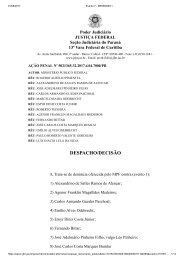Brasil só deve dominar Leitura em 260 anos, aponta estudo do Banco Mundial Relatorio Banco Mundial _Learning
Create successful ePaper yourself
Turn your PDF publications into a flip-book with our unique Google optimized e-Paper software.
students. Well-prepared, motivated teachers <strong>do</strong> not<br />
need to operate in the dark: they know how to assess<br />
the learning of students regularly, formally and<br />
informally. As the next section discusses, this type of<br />
regular check-in is important because many students<br />
lag so far behind that they effectively stop learning.<br />
Knowing where students are allows teachers to<br />
adjust their teaching accordingly and to give students<br />
learning opportunities they can handle. Singapore<br />
has successfully used this approach—identifying<br />
lagging students in grade 1 using screening tests and<br />
then giving th<strong>em</strong> intensive support to bring th<strong>em</strong> up<br />
to grade level. 63<br />
National and subnational learning assessments<br />
provide syst<strong>em</strong>-level insights that classroom assessments<br />
by teachers cannot. To guide an education<br />
syst<strong>em</strong>, policy makers need to understand whether<br />
students are mastering the national curriculum, in<br />
which areas students are stronger or weaker, whether<br />
certain population groups are lagging behind and<br />
by how much, and which factors are associated with<br />
better student achiev<strong>em</strong>ent. There is no effective way<br />
to aggregate the results of classroom-level formative<br />
assessment by teachers into this type of reliable<br />
syst<strong>em</strong>-level information. This is why syst<strong>em</strong>s need<br />
assessments of representative samples of students<br />
across wider jurisdictions, such as countries or provinces.<br />
Such assessments can be an especially important<br />
part of tracking syst<strong>em</strong>wide progress because<br />
they are anchored in a syst<strong>em</strong>’s own expectations for<br />
itself. And national assessments can provide a check<br />
on the quality of subnational assessments by flagging<br />
cases in which trends or levels of student achiev<strong>em</strong>ent<br />
diverge across the two. In the United States,<br />
the National Assessment of Educational Progress has<br />
played this role. 64<br />
International assessments also provide information<br />
that helps improve syst<strong>em</strong>s. Globally benchmarked<br />
student assessments such as PISA, TIMSS,<br />
and PIRLS, as well as regionally benchmarked ones<br />
such as PASEC in West and Central Africa and the<br />
Latin American Laboratory for Assessment of the<br />
Quality of Education (LLECE), provide an additional<br />
perspective on how well students are learning. They<br />
allow assessment of country performance in a way<br />
that is comparable across countries, and they provide<br />
a check on the information that <strong>em</strong>erges from<br />
national assessments. And international assessments<br />
can be powerful tools politically: because country<br />
leaders are concerned with national productivity and<br />
competitiveness, international benchmarking can<br />
raise awareness of how a country is falling short of its<br />
peers in building human capital.<br />
Two other types of learning metrics measured<br />
in nonschool settings can be used to strengthen the<br />
quality and equity focus of assessment syst<strong>em</strong>s.<br />
Grassroots accountability mov<strong>em</strong>ents—led by civil<br />
society organizations such as the ASER Centre in India<br />
and Uwezo in East Africa—have deployed citizen-led<br />
assessments that recruit volunteers to measure the<br />
foundational learning of young children in their<br />
communities. These organizations then use their<br />
learning data to advocate for education reform. Some<br />
multipurpose household surveys also collect learning<br />
data, enabling researchers to analyze how learning<br />
outcomes correlate with income and community<br />
variables. Both types of assessments are administered<br />
in people’s homes, not schools. As a result, they<br />
<strong>do</strong>n’t suffer from a key weakness of school-based<br />
assessments: when marginal students drop out, their<br />
absence can improve the average scores on school<br />
assessments, thereby creating a perverse incentive<br />
for school leaders. But household-based assessments<br />
yield learning metrics that reward syst<strong>em</strong>s for<br />
improving both access and quality. This is crucial to<br />
ensuring that no child is written off. Even for students<br />
who are in school, household-based assessments provide<br />
an alternative source of learning data, which can<br />
be important in settings where official assessments<br />
are of questionable quality.<br />
Measur<strong>em</strong>ent can be hard<br />
Why isn’t there more and better measur<strong>em</strong>ent of<br />
learning? As with syst<strong>em</strong> barriers to learning, barriers<br />
to better measur<strong>em</strong>ent are both technical and<br />
political. From a technical perspective, conducting<br />
good assessments is not easy. At the classroom<br />
level, teachers lack the training to assess learning<br />
effectively, especially when assessments try to capture<br />
higher-order skills—say, through project-based<br />
assessment—rather than rote learning. And at the<br />
syst<strong>em</strong> level, education ministries lack the capacity<br />
to design valid assessments and impl<strong>em</strong>ent th<strong>em</strong> in a<br />
sample of schools. Political factors intrude as well. To<br />
paraphrase an old saying, policy makers may decide<br />
it is better to avoid testing and be assumed ineffective<br />
than to test students and r<strong>em</strong>ove all <strong>do</strong>ubt.<br />
And even when they <strong>do</strong> participate in assessments,<br />
governments sometimes decline to release the learning<br />
results to the public, as happened with the 1995<br />
TIMSS in Mexico. 65 Finally, if assessments are poorly<br />
designed or inappropriately made into high-stakes<br />
18 | World Development Report 2018








